Janome Memory Craft 400E Instruction Manual
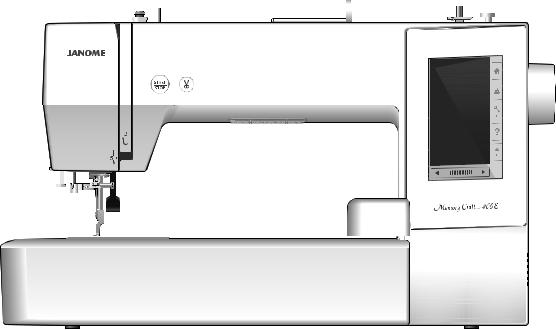
Instruction Book

IMPORTANT SAFETY INSTRUCTIONS
When using an electrical appliance, basic safety precautions should always be followed, including the following:
This sewing machine is designed and manufactured for household use only.
Read all instructions before using this sewing machine.
DANGER— To reduce the risk of electric shock:
1.An appliance should never be left unattended when plugged in. Always unplug this sewing machine from the electric outlet immediately after using and before cleaning.
WARNING— To reduce the risk of burns, fire, electric shock, or injury to persons:
1.Do not allow to be used as a toy. Close attention is necessary when this sewing machine is used by or near children.
2.Use this appliance only for its intended use as described in this owner’s manual.
Use only attachments recommended by the manufacturer as contained in this owner’s manual.
3.Never operate this sewing machine if it has a damaged cord or plug, if it is not working properly, if it has been dropped or damaged, or dropped into water.
Return this sewing machine to the nearest authorized dealer or service center for examination, repair, electrical or mechanical adjustment.
4.Never operate the appliance with any air opening blocked. Keep ventilation openings of this sewing machine and foot controller free from accumulation of lint, dust and loose cloth.
5.Never drop or insert any object into any opening.
6.Do not use outdoors.
7.Do not operate where aerosol (spray) products are being used or where oxygen is being administered.
8.To disconnect, turn all controls to the off (“O”) position, then remove plug from outlet.
9.Do not unplug by pulling on cord. To unplug, grasp the plug, not the cord.
10.Keep fingers away from all moving parts. Special care is required around the sewing machine needle and/or cutting blade.
11.Always use the proper needle plate. The wrong plate can cause the needle to break.
12.Do not use bent needles.
13.Do not pull or push fabric while stitching. It may deflect the needle causing it to break.
14.Switch this sewing machine off (“O”) when making any adjustment in the needle area, such as threading the needle, changing the needle, threading the bobbin or changing the presser foot, and the like.
15.Always unplug this sewing machine from the electrical outlet when removing covers, lubricating, or when making any other adjustments mentioned in this owner’s manual.
SAVE THESE INSTRUCTIONS
For Europe only:
This appliance can be used by children aged from 8 years and above and persons with reduced physical, sensory or mental capabilities or lack of experience and knowledge if they have been given supervision or instruction concerning use of the appliance in a safe way and understand the hazards involved. Children shall not play with the appliance. Cleaning and user maintenance shall not be made by children without supervision.
For outside Europe (except U.S.A and Canada):
This appliance is not intended for use by persons (including children) with reduced physical, sensory or mental capabilities, or lack of experience and knowledge, unless they have been given supervision or instruction concerning use of the appliance by a person responsible for their safety.
Children should be supervised to ensure that they do not play with the appliance.
 Please note that on disposal, this product must be safely recycled in accordance with relevant
Please note that on disposal, this product must be safely recycled in accordance with relevant 

 National legislation relating to electrical/electronic products. If in doubt please contact your
National legislation relating to electrical/electronic products. If in doubt please contact your  retailer for guidance. (European Union only)
retailer for guidance. (European Union only)
TABLE OF CONTENTS
GETTING READY TO SEW |
|
Names of Parts............................................................... |
3 |
Standard Accessories.................................................. |
4-5 |
Connecting the Power Supply......................................... |
6 |
Machine Operating Buttons............................................ |
6 |
Raising and Lowering the Presser Foot.......................... |
7 |
Common Keys................................................................. |
7 |
Setting the Spool of Thread............................................ |
8 |
Extra spool pin............................................................. |
8 |
Winding the Bobbin.................................................... |
8-10 |
Removing the bobbin................................................... |
8 |
Winding the bobbin...................................................... |
9 |
Inserting the bobbin................................................... |
10 |
Threading the Machine.................................................. |
11 |
Built-in Needle Threader............................................... |
12 |
Replacing Needles........................................................ |
13 |
Fabric and Needle Chart............................................... |
13 |
On-screen Help............................................................. |
14 |
Removing and Attaching the Embroidery Foot............. |
15 |
Bobbin Holder for Embroidery (high tension)................ |
16 |
Embroidery Hoops........................................................ |
16 |
Stabilizers..................................................................... |
17 |
Types of the stabilizers.............................................. |
17 |
Setting the Fabric in an Embroidery Hoop.................... |
18 |
Attaching the Embroidery Hoop to the Machine........... |
19 |
Thread Holder............................................................... |
20 |
Selecting Built-in Embroidery Designs......................... |
20 |
Monogramming............................................................. |
21 |
Function Keys............................................................... |
22 |
Programming a Monogram...................................... |
23-24 |
Color change.............................................................. |
23 |
Monogram placement................................................ |
23 |
2-Letter monogram.................................................... |
24 |
Editing a Monogram...................................................... |
25 |
Ready to Sew Window............................................. |
26-31 |
Function keys............................................................. |
26 |
Pattern information..................................................... |
26 |
Stitch back/forward keys............................................ |
27 |
Jump key.................................................................... |
27 |
Cross mark................................................................. |
27 |
Color section key....................................................... |
27 |
Trace key.................................................................... |
28 |
Thread color/Jog key.................................................. |
28 |
Fine position/angle adjustment key........................... |
29 |
Rotating a design....................................................... |
29 |
Moving a design......................................................... |
29 |
Color list key.............................................................. |
30 |
Adjust key................................................................... |
30 |
Auto thread tension level........................................ |
30 |
Cutting the tails of jump threads............................. |
30 |
Hoop back key........................................................... |
31 |
Starting to Sew Embroidery.......................................... |
32 |
Editing Mode............................................................ |
33-43 |
Selecting a hoop size................................................. |
33 |
Opening the embroidery designs............................... |
33 |
Editing tool bar information........................................ |
34 |
Selecting a pattern..................................................... |
34 |
Moving a pattern........................................................ |
34 |
Duplicating a pattern.................................................. |
35 |
Deleting a pattern....................................................... |
35 |
Resizing a pattern...................................................... |
35 |
Rotating a pattern...................................................... |
36 |
Flipping a pattern....................................................... |
36 |
Monogramming in an arc........................................... |
37 |
Grouping patterns...................................................... |
38 |
Customizing the display colors.................................. |
39 |
Color grouping........................................................... |
40 |
Sewing order.............................................................. |
41 |
Center positioning...................................................... |
41 |
Creating a square frame............................................ |
42 |
Single color sewing.................................................... |
42 |
Zooming in the editing window.................................. |
43 |
Pantry Designs for Applique.................................... |
44-45 |
Alternative method..................................................... |
45 |
Celebration Designs...................................................... |
46 |
Bracelet Designs........................................................... |
47 |
CUSTOMIZING MACHINE SETTINGS |
|
Machine Setting Mode.................................................. |
48 |
Registering the custom settings................................. |
48 |
Common Setting Mode............................................ |
49-50 |
CUSTOMIZING EMBROIDERY MODE SETTINGS |
|
Embroidery Mode Settings...................................... |
51-54 |
Language Selection Mode............................................ |
54 |
Saving and Opening a File............................................ |
55 |
Creating a new folder................................................. |
55 |
Deleting a file or folder............................................... |
56 |
Opening a file............................................................. |
56 |
Changing a name of the file or folder......................... |
57 |
CARE AND MAINTENANCE |
|
Cleaning the Hook Area................................................ |
58 |
Cleaning the Thread Path............................................. |
59 |
Oiling the Machine................................................... |
60-64 |
Troubleshooting............................................................ |
65 |
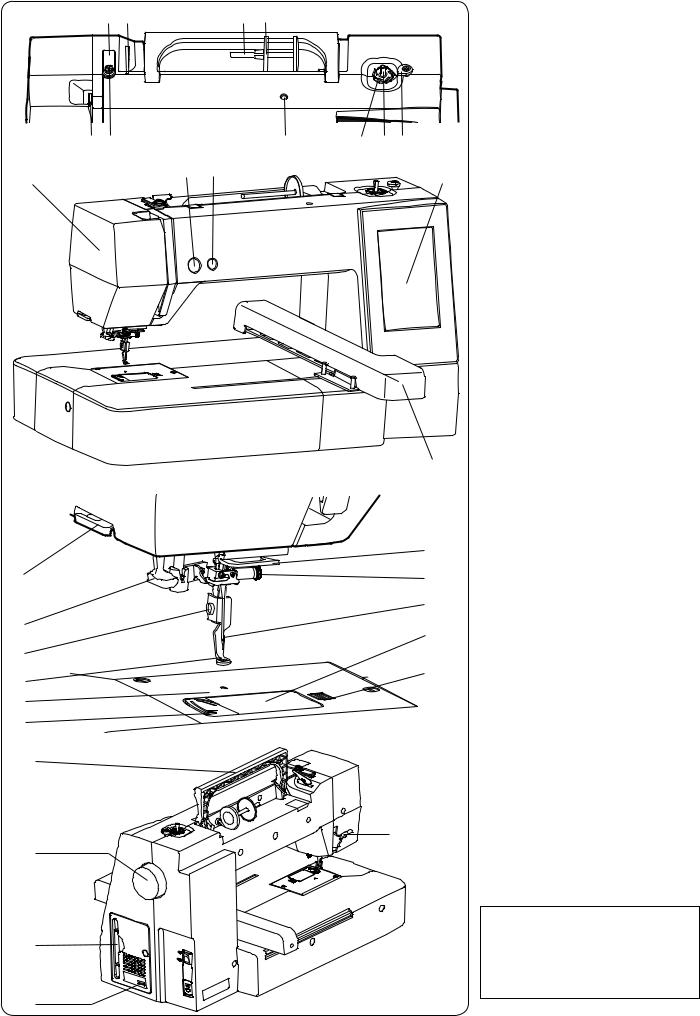
!1
!6
!7
!8
!9
@0
@1
w e |
t y |
q r |
u |
!2!3
i o !0
!4
!5
GETTING READY TO SEW
Names of Parts
q Thread take-up lever w Upper thread guide
e Pre-tension thread guide r Bobbin winder thread guide t Spool pin
y Spool holder (large) u Hole for extra spool pin i Bobbin thread cutter o Bobbin winder spindle !0Bobbin winder stopper
!1Face plate
!2Start/stop button
!3Thread cutter button !4Visual touch screen !5Carriage
|
!6Thread cutter/holder |
|
!7Needle threader |
@2 |
!8Setscrew |
@3 |
!9Embroidery foot |
@0Needle plate |
|
@4 |
@1Thread cutter |
@5 |
@2Lower thread guide |
|
@3Needle clamp screw |
@6 |
@4Needle |
@5Hook cover plate |
@6Hook cover release button
@7
#1
@8
@9

 #2
#2
 #3
#3
#0
* Design and specifications are subject to change without prior notice.
@7Carrying handle @8Handwheel
@9Touch panel stylus holder
#0USB port (type A)
#1Presser foot lifter #2Power switch #3Power inlet
NOTE:
To carry the sewing machine, hold the carrying handle with your hand, and support the sewing machine with the other hand.
3

q w e r
t y u
i o !0 !1
!2 !3 !4
!5 !6 !7
!8 !9
Standard Accessories
qBobbin x 5 (1 set on the machine) wScrewdriver (Large)
eScrewdriver key (for needle plate) rLint brush
tScissors yNeedle set
uSpool holder (large) X 2 (1 set on the machine) iSpool holder (small) X 2
oSpool holder (special) X 2
!0Extra spool pin
!1Special bobbin holder for Embroidery (high tension)*
!2Touch panel stylus !3Bobbin holder cleaner !4Instruction book !5Quick reference guide !6Template CD !7Instructional DVD
!8Soft machine cover
!9Power cable**
* Set on the machine for some models.
** The power cable included may differ from the illustration.
4

@0 @1
@2 @3
@0Embroidery hoop SQ14b (with template)***
@1Embroidery hoop RE20b (with template)***
@2Embroidery hoop SQ20b (with template)*** @3Clamp X 8
***The embroidery hoops supplied with your machine vary depending on your model.
5

q
w
e t r
q w
e
Connecting the Power Supply
z First make sure the power switch q is off.
xInsert the machine plug w of the power supply cord into the power inlet e.
cInsert the power supply plug r into the wall outlet t, and turn the power switch q on.
qPower switch wMachine plug ePower inlet rPower supply plug tWall outlet
NOTE:
Make sure to use the power cable that came with the machine.
If you turn off the power switch, wait for 5 seconds before turning it on again.
WARNING:
While in operation, always keep your eyes on the sewing area, and do not touch any moving parts such as the thread take-up lever, handwheel or needle. Always turn off the power switch and unplug the machine from the power supply:
-when leaving the machine unattended.
-when attaching or removing parts.
-when cleaning the machine.
For the U.S.A. and Canada only
Polarized plug (one blade wider than the other):
To reduce the risk of electric shock, this plug is intended to fit in a polarized outlet only one way. If it does not fit fully in the outlet, reverse the plug. If it still does not fit, contact a qualified electrician to install the proper outlet.
Do not modify the plug in any way.
Machine Operating Buttons
q Start/stop button
Press this button to start or stop the machine. The button turns red when the machine is running, and green when it stops.
w Thread cutter button
Press this button when you finish sewing to trim the threads. The needle bar automatically rise after trimming the threads.
NOTE:
If you press the start/stop button without lowering the presser foot, the warning message e appears on the visual touch screen.
Lower the presser foot and press the start/stop button.
6
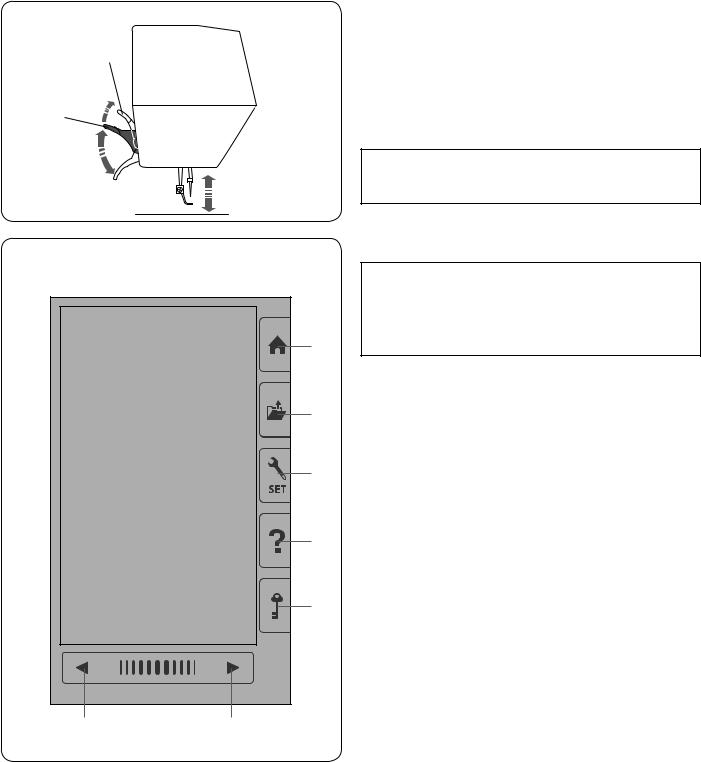
w
q
|
q |
|
w |
|
e |
|
r |
|
t |
u |
y |
Raising and Lowering the Presser Foot
You can raise and lower the presser foot with the presser foot lifter.
q Presser foot lifter w Extra lifted position
You can raise the presser foot about 7 mm (1/4˝) higher than the normal up position by exerting more pressure when lifting the presser foot lifter.
NOTE:
Do not turn the hand wheel when the presser foot is in the extra lifted position.
Common Keys
 CAUTION:
CAUTION:
Do not press the visual touch screen with hard or sharp objects like pencils, screwdrivers or the like.
Use the touch panel stylus included in the standard accessories.
q Home key
Press this key to enter the category selection.
w Open file key
Press this key and the open file window will open.
You can open embroidery designs saved in the machine’s internal memory or on a USB flash drive.
e Set mode key
Press this key to enter the setting mode. You can customize the machine settings to your preference. The machine settings for common settings, embroidery and language selection are available in this mode.
r Help key
Press this key to view the step-by-step visual guide about the essential operations.
t Lockout key
Press this key to lockout the machine when threading the machine, replacing the accessories etc.
To reduce the risk of injury, all the buttons and keys are deactivated.
To unlock the machine, press the lockout key t again.
y Next page key
To view the next page, press the next page key.
u Previous page key
To view the previous page, press the previous page key.
7

Setting the Spool of Thread
Lift up the spool pin. Place the spool of thread on the spool pin.
Attach the large spool holder, and press it firmly against the spool of thread.
NOTE:
Use the small spool holder to hold narrow or small spools of thread.
|
q |
Use the spool holder (special) to hold the specific size of |
|
|
|
the spool of threads as shown. |
|
|
|
The sizes of the spools of thread are as follows; |
|
|
|
The hole diameter of the spool has a range of 3/8˝ to |
|
|
w |
7/16˝ (9.5 to 10.5 mm)), and the spool length has a range |
|
|
of 2 3/4˝ to 3˝ (70 to 75 mm). |
||
|
e |
q Spool holder (special) |
|
|
|
w Hole diameter (3/8˝ to 7/16˝) |
|
q |
w |
e Spool length (2 3/4˝ to 3˝) |
|
|
|
Firmly insert the spool holder (special) into the hole and |
|
|
|
hold the spool as illustrated. |
|
|
q |
Extra spool pin |
|
e |
Use the extra spool pin when you need to wind a bobbin |
||
|
|||
|
|
without unthreading the machine while working on a |
|
|
|
sewing project. |
|
|
|
Insert the extra spool pin into the hole as shown. |
|
|
|
Place a spool of thread on the extra spool pin and fix the |
|
|
|
spool with the spool holder. |
|
|
w |
q Extra spool pin |
|
|
|
w Hole for extra spool pin |
|
|
|
e Large spool holder |
|
|
|
Draw the thread to the left and forward around the bobbin |
|
|
|
winder thread guide as shown. |
|
|
|
Firmly pull the thread to the right. |
|
|
|
Follow the procedure from x to , of page 9 to wind the |
|
|
|
bobbin. |
|
|
|
Winding the Bobbin |
|
|
|
Removing the bobbin |
|
z |
w |
CAUTION: |
|
|
|||
|
|
||
|
q |
Press the lockout key or turn the power switch off. |
|
|
|
||
|
|
z Slide the hook cover release button q to the right, |
|
|
|
and remove the hook cover plate w. |
|
|
|
q Hook cover release button |
|
|
|
w Hook cover plate |
|
x |
|
x Remove the bobbin e from the bobbin holder. |
|
|
e |
e Bobbin |
|
|
NOTE: |
||
|
|
||
|
|
Use the plastic bobbins for horizontal hook marked |
|
|
|
with a “J” r. Using other bobbins, such as pre-wound |
|
|
|
paper bobbins, may cause stitching problems and/ |
|
|
r |
or damage to the bobbin holder. |
8

zq
x w |
c |
|
e |
v
r 
 t
t
b
e
u
n 
 m
m
i
,
Winding the bobbin
zDraw the thread from the spool.
Guide the thread around the bobbin winder thread guide.
q Bobbin winder thread guide
x Put the bobbin on the bobbin winder spindle. wBobbin
eBobbin winder spindle
c Pass the thread to the bobbin.
Hold the thread with both hands and wind it around the bobbin clockwise several times.
vInsert the thread into one of the slits t of the flange plate r and pull the thread to cut.
rFlange plate tSlit
bPush the bobbin winder spindle e to the right.
The visual touch screen will show the bobbin winding sign.
If you wish to wind the bobbin thread more quickly or slowly, you can adjust the maximum bobbin winding speed by pressing the “+” key y or “–” key u.
NOTE:
yDo not move the bobbin winder spindle while the machine is running.
n Press the start/stop button i. iStart/stop button
When the bobbin is fully wound, it will stop spinning automatically.
Press the start/stop button i to stop the machine.
mReturn the bobbin winder to its original position by moving the spindle to the left.
,Remove the bobbin.
Insert the thread into one of the slits of the flange plate and pull the thread to cut.
NOTE:
For safety purposes, the machine will automatically stop 1.5 minutes after starting bobbin winding.
9
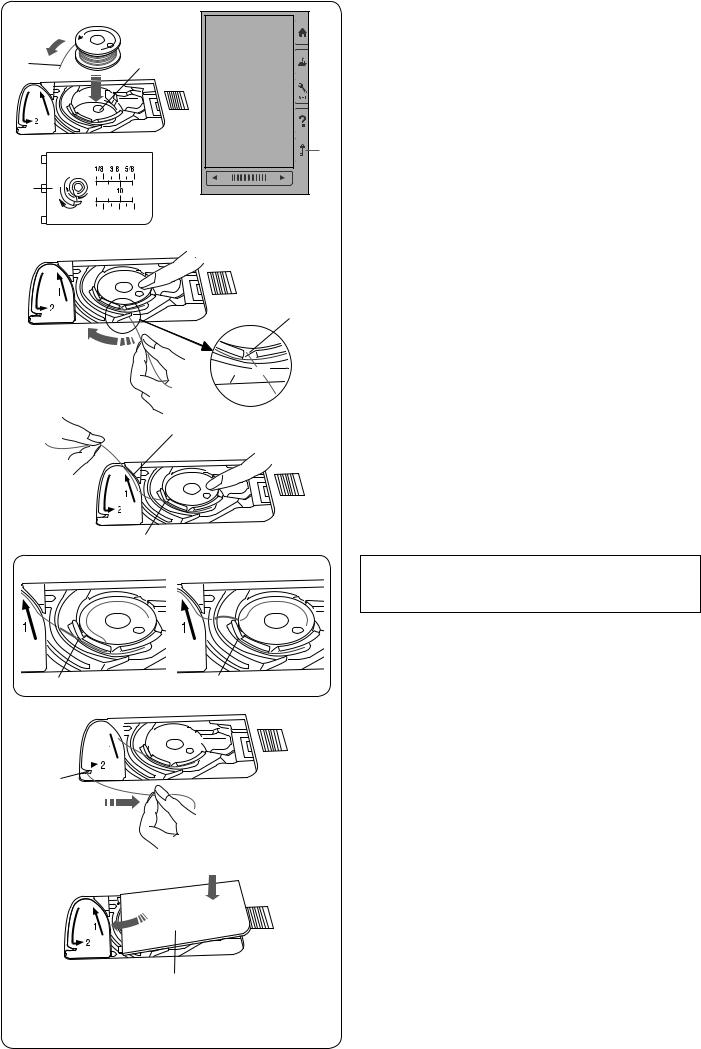
|
|
Inserting the bobbin |
z |
|
z Press the lockout key. |
|
|
Place a bobbin in the bobbin holder with the thread |
w |
e |
running off counterclockwise as shown on the hook |
|
|
cover plate. |
|
|
qLockout key |
|
|
wEnd of thread |
|
|
eBobbin holder |
|
q |
rHook cover plate |
r |
|
|
x |
|
x Hold the bobbin with your fingertip so it does not |
|
|
rotate. |
|
|
Guide the thread into the front notch of the bobbin |
|
|
holder. |
|
t |
Pull the thread to the left to pass it under the guide. |
|
tFront notch |
|
|
|
|
|
|
yGuide |
 y
y
c u
|
i |
Correct |
Wrong |
ii
v o



!0
b
cDraw the thread to the left to pass it into the guide path marked “1”.
Make sure that the thread comes out from the side notch of the bobbin holder.
uGuide path 1 iSide notch
NOTE:
If the thread does not come out from the side notch, rethread from step z.
vContinue to draw the thread along the guide path marked “2” and pull the thread to the right through the slit. The thread will be cut to a proper length and held in place.
oGuide path 2
!0Slit (Thread cutter)
bSet the left edge of the hook cover plate into opening. Push down the hook cover plate to fit in place.
r
10

 q
q
z
w
Threading the Machine
Raise the presser foot lifter.
Press the lockout key to lockout the machine.
Turn the handwheel toward you to raise the needle at its highest position.
q Lockout key
Pass the thread in order from z to m.
zPull the thread from the spool.
Hold the thread with both hands and pass the thread into the slit of the pre-tension thread guide.
w Slit
x |
|
|
|
e |
|
|
x Wind the thread around the pre-tension thread guide |
|
|
|
once as shown. |
|
|
|
Draw the thread around the corner of the upper thread |
|
|
|
guide. |
|
|
|
Firmly pull the thread toward you along the right |
|
|
|
channel until the thread snaps. |
|
|
|
e Pre-tension thread guide |
|
r |
|
r Upper thread guide |
|
|
t Right channel |
|
y |
|
|
|
|
|
|
|
|
|
|
NOTE: |
|
|
|
If the thread slips out of the pre-tension thread guide |
|
|
|
while sewing, wind the thread through the hole as |
|
|
|
shown y when threading through the pre-tension |
u |
|
|
thread guide. |
|
|
t |
NOTE: |
|
|
If the thread coming out from the needle eye is too |
|
|
|
|
|
|
|
|
short after auto thread cutting and skipped stitch |
|
|
|
occurs, draw the thread through the pre-tension |
|
|
|
thread guide as shown u. |
c |
v |
!0 |
c Draw the thread down along the right channel and |
|
|
||
|
|
|
around the bottom of the thread guide plate. |
|
|
|
Pull the thread up along the left channel. |
o |
|
|
t Right channel |
|
|
i Thread guide plate |
|
|
|
|
|
|
|
|
o Left channel |
|
|
|
v While holding the thread at the spool, firmly draw the |
t |
|
|
thread up and to the back of the take-up lever. Draw |
|
|
|
the thread forward to draw it into the eye of the take- |
i |
|
|
up lever. |
|
|
|
!0Eye of the take-up lever |
b n m
!1
bThen pull the thread down along the left channel and through the lower thread guide.
!1Lower thread guide
nSlide the thread behind the needle bar thread guide on the left.
!2Needle bar thread guide
!2 |
m Thread the needle with the needle threader (refer to |
|
the next page). |
11

z
w
 q
q
x
Built-in Needle Threader
NOTE:
The needle threader can be used with a #11 to #14 needle.
Thread size 50 to 90 is recommended. Do not use thread size 30 or thicker.
zPress the lockout key to lock the machine. Lower the presser foot.
Turn the handwheel toward you to until the needle thread sign w appears on the right upper corner of the lockout window.
q Lockout key
w Needle threader sign
x Pull down the needle threader knob as far as it will go. The threader hook comes out through the needle eye from behind.
e Threader knob r Threader hook
e |
r |
c Draw the thread from left to right, under the left guide, |
|
|
|
c |
|
threader hook and right guide. |
|
|
Draw the thread around the right guide toward you. |
|
|
t Left guide |
|
|
y Right guide |
|
y |
|
t |
v |
v Raise the threader slowly so a loop of the thread is |
|
pulled up through the needle eye. |
|
u Threader loop |
|
u |
b |
b Remove the thread end through the needle eye to the |
|
rear. |
12

q |
w
e
r

Replacing Needles
 CAUTION:
CAUTION:
Always make sure to press the lockout key to lockout the machine or turn the power switch off before replacing the needle.
A loose needle or a loose screw may cause machine malfunction or needle to break.
Raise the needle by turning the handwheel.
Turn the power switch off or press the lockout key. q Lockout key
Loosen the needle clamp screw by turning it counterclockwise.
Remove the needle from the clamp. w Needle clamp screw
Insert a new needle into the needle clamp with the flat side of the needle to the rear.
e Flat side
When inserting the needle into the needle clamp, push it up against the stopper pin and tighten the needle clamp screw firmly with a screwdriver.
To check needle straightness, place the flat side of the needle onto something flat (a needle plate, glass etc.). The gap between the needle and the flat surface should be consistent.
r Gap
Never use a blunt needle.
NOTE:
Use size 11 blue tipped needle for fine fabrics.
For medium to heavy weight fabrics, use size 14 needles.
Fabric and Needle Chart
Fabric |
Thread |
Needle |
Fine |
|
Blue tip needle |
|
|
or |
|
|
|
Medium |
|
EL x 705 |
|
Embroidery thread |
Size 12/80 |
|
Universal needle #14 |
|
|
|
|
Heavy |
|
or |
weight |
|
EL x 705 |
|
|
Size 14/90 |
Janome bobbin thread for embroidery is recommended for bobbin.
13

q |
w |
On-screen Help
Press the help key to open the help menu.
You can view instructions on 4 topics of essential operations of the machine.
Select the help topic by pressing the book icon and the step-by-step instruction will open.
q Help key w Book icon
|
t |
To view the next page, press the next page key. |
|
To view the previous page, press the previous page key. |
|
|
|
Press the X key to close the current window. |
|
|
e Next page key |
|
|
r Previous page key |
|
|
t X key |
r |
e |
|
14
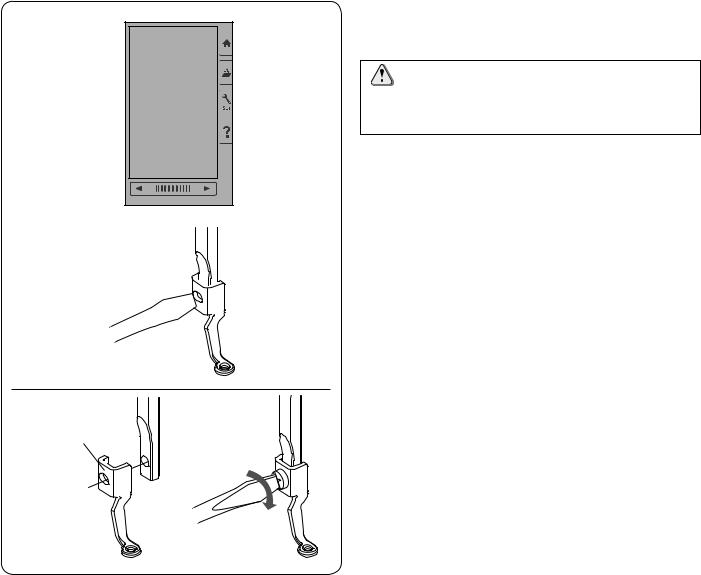
z
 q
q
x

 w
w
z x
e
w


Removing and Attaching the Embroidery Foot
Remove the embroidery foot when removing the needle plate for the maintenance, etc.
CAUTION:
Always make sure to press the lockout key to lockout the machine or turn the power switch off before removing or attaching the embroidery foot.
To remove:
zTurn the power switch off or press the lockout key. Raise the needle by turning the handwheel toward you.
q Lockout key
xLoosen the setscrew with the screwdriver and remove the embroidery foot.
w Setscrew
To attach:
zAttach the embroidery foot to the presser bar from the left side.
w Setscrew
e Embroidery foot
x Tighten the setscrew securely with the screwdriver.
15

q
z
w
x
 e r
e r
t
qw
e r
Bobbin Holder for Embroidery (high tension)
Replace the standard bobbin holder with the bobbin holder for embroidery (high tension) when using bobbin threads other than Janome bobbin thread for embroidery.
 CAUTION:
CAUTION:
Always make sure to press the lockout key to lockout the machine or turn the power switch off before attaching the bobbin holder.
NOTE:
•The special bobbin holder for embroidery
(high tension) is marked with a yellow dot for identification.
q Yellow dot
•The special bobbin holder for embroidery (high tension) is already installed in the machine for some models.
zRemove the needle, embroidery foot and needle plate (refer to the pages 13, 15 and 58).
Take out the standard bobbin holder. w Standard bobbin holder
xInsert the special bobbin holder into the hook race. Make sure to match the knob of the bobbin holder with the stopper on the machine.
Attach the needle plate, presser foot and needle. e Knob
r Stopper
t Special bobbin holder for embroidery (high tension)
NOTE:
Use the standard bobbin holder when sewing quilting designs that use the same thread for the bobbin as the needle thread.
Embroidery Hoops
q Embroidery hoop SQ14b
A square embroidery hoop with a 14 cm (5.5˝) square embroidery area.
w Embroidery hoop RE20b
An extra large embroidery hoop with a 14 cm by 20 cm
(5.5˝ by 7.9˝) embroidery area.
e Embroidery hoop SQ20b
A square embroidery hoop with a 20 cm (7.9˝) square embroidery area.
r Clamp (RE20b and SQ20b)
A clamp for holding the fabric to the embroidery hoops
RE20b and SQ20b.
*The embroidery hoops supplied with your machine vary depending on your model.
16

Stabilizers
To create the best quality embroidery, it is important to use stabilizers.
How to use:
Attach the stabilizer to the wrong side of the fabric. You may need to use more than one layer.
For firm fabrics, you may place a thin sheet of paper under the fabric.
The non-adhesive type should be used when embroidering fabric which cannot be ironed or for sections which are difficult to iron.
Cut the stabilizer larger than the embroidery hoop and set it on the hoop so that the entire piece is fastened to the hoop to prevent any looseness in the fabric.
Attaching the stabilizer
Place the wrong side of fabric and the glossy side of the stabilizer together. Fold up a corner of the stabilizer and fuse it with an iron.
NOTE:
Fold up a corner of the stabilizer, to make it easier to peel off the excess stabilizer after stitching. Ironing temperatures vary depending on the kind of adhesive stabilizer you are using.
Types of the stabilizers
Type |
Usage |
Property |
Tear-away |
Stable woven fabrics |
Made from a fiber that will tear easily. |
Iron-on |
Knits and all kinds of unstable fabrics |
Adhesive type fusible with an iron. |
Cut-away |
Knits and all kinds of unstable fabrics |
Non-woven fabric that does not tear. |
Water soluble |
Cutwork or lace embroidery |
A thin film that will dissolve in water. |
|
Right side of looped fabrics such as towels to avoid loops |
|
|
coming through the embroidery |
|
Heat-away |
Cutwork or lace embroidery |
A thin film that will melt away with |
|
|
heat. |
NOTE:
Sticky type stabilizers can be used only for securing a small piece of fabric or work that cannot be secured in the hoop, or for securing velvet and other napped fabric that would be permanently marked by the hoop.
Clean the bobbin holder after stitching as glue can get stuck on it.
17

z |
Setting the Fabric in an Embroidery Hoop |
|
q |
||
|
z Prepare a fabric and attach a stabilizer to the wrong side of the fabric.
The fabric and stabilizer should be larger than the hoop size.
Draw the centerlines on the fabric with tailor’s chalk.
wq Fabric
w Centerlines
x |
|
x Lay the inner hoop and template on the fabric, |
|
e |
matching the centerlines of the fabric with the |
|
template. |
|
|
|
|
|
|
e Inner hoop |
|
|
r Template |
|
r |
|
c |
|
c Loosen the hoop tightening screw on the outer hoop. |
|
|
Place the inner hoop and fabric on the outer hoop. |
|
|
t Hoop tightening screw |
|
|
y Outer hoop |
|
y |
|
t |
v |
v Push the inner hoop and fabric into the outer hoop. |
|
Tighten the screw on the outer hoop to stretch the |
|
fabric. Make sure that the fabric is stretched tightly in |
|
the hoop. |
|
Remove the template. |
b |
b Clamp the fabric to the hoop with the clamps when |
|
using hoop SQ20b or RE20b. |
|
u Clamp |
u |
NOTE: |
Thick layers of fabric and stabilizer may cause |
|
|
skipped stitches, or broken threads and needles. |
|
Avoid sewing on the layers thicker than 3 mm (1/8˝). |
18
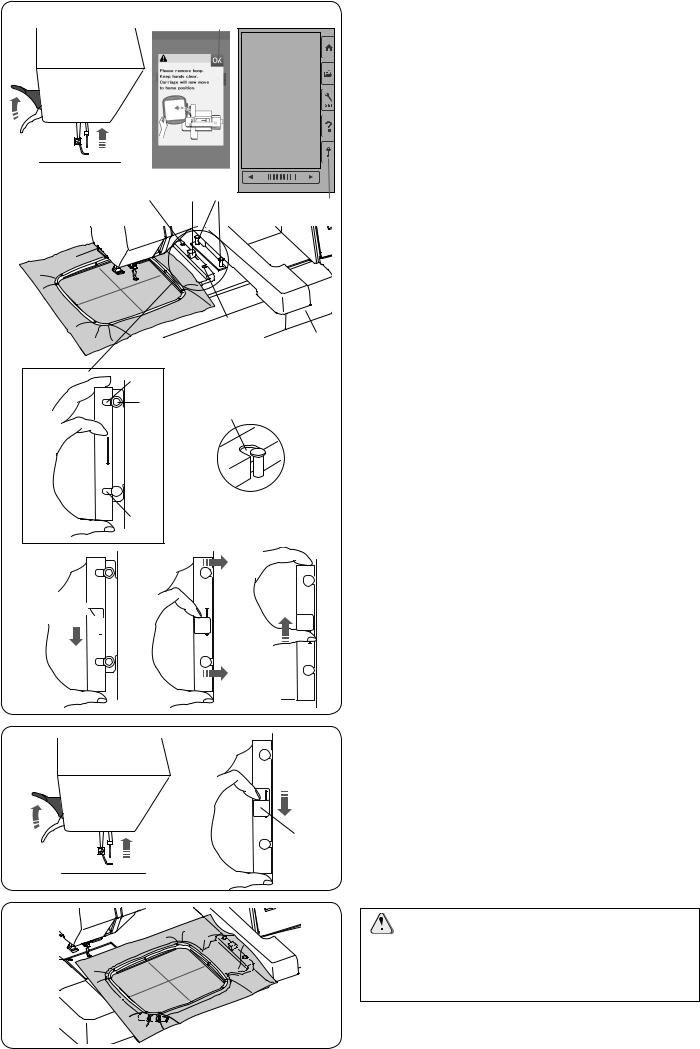
z |
q |
Attaching the Embroidery Hoop to the Machine |
|
To attach: |
|||
|
|
||
|
|
z Raise the presser foot. |
|
|
|
Turn the handwheel toward you to raise the needle at |
|
|
|
its highest position. Turn the power switch on. |
|
|
|
If the carriage is not at the home position, the caution |
|
|
|
message appears to move the carriage to the home |
|
|
|
position. |
|
|
|
Press OK key to move the carriage to the home |
|
|
|
position. |
|
|
|
q OK key |
|
e |
y r |
Select or edit the desired pattern and press OK key. |
|
|
w |
Ready to Sew screen appears and the carriage moves |
|
x |
|
to the start position. |
|
|
|
Press the lockout key to lockout the machine. |
|
|
|
wLockout key |
|
|
|
x Place the prepared hoop on the machine. |
|
e |
|
Position the hoop by aligning the notches of the hoop |
|
|
with the carriage pins. |
|
|
|
t |
|
|
|
e Notch |
|
|
|
|
|
|
|
|
r Carriage pin |
e |
|
|
t Carriage |
r |
e |
|
yLever |
|
|
|

 y
y
 r
r

 r
r  e
e
c  v
v b
b
 y
y
zx 
y
 u
u
c Shift the lever in the direction of the arrow. yLever
vAttach the hoop by pushing it against the carriage pins.
bPush the lever in the direction of arrow to lock the hoop in place.
To remove:
zRaise the presser foot. Turn the handwheel toward you to raise the needle at its highest position. Press the lockout key to lock the machine.
x Shift the lever in the direction of the arrow and remove the hoop.
yLever
CAUTION:
•Be careful not to place the excess of fabric between the carriage and machine body u.
•Never try to move the carriage by hand or touch the carriage while it is moving.
19
